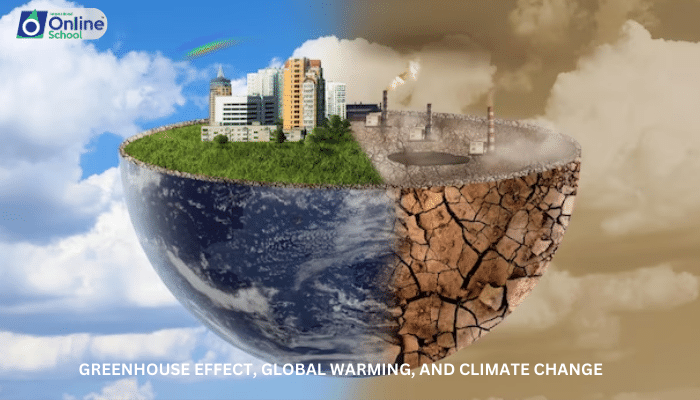
Learning Outcomes
By the end of this lesson, students should be able to:
i. Define the term greenhouse effect and explain the role of greenhouse gases, such as carbon dioxide (CO2), methane (CH4), and nitrous oxide (N2O), in trapping heat within the Earth's atmosphere.
ii. Differentiate between weather and climate, recognizing that weather refers to short-term atmospheric conditions, while climate refers to long-term weather patterns.
iii. Explain the concept of global warming, highlighting the observed increase in average global temperatures over the past century and its association with the enhanced greenhouse effect.
iv. Identify the primary drivers of global warming, including the burning of fossil fuels, deforestation, and industrial processes, which lead to increased emissions of greenhouse gases.
v. Analyze the potential consequences of climate change, including rising sea levels, extreme weather events, and disruptions to ecosystems and human activities.
vi. Appreciate the importance of international agreements, such as the Paris Agreement, in addressing climate change through mitigation and adaptation strategies.
Introduction
The Earth's climate has undergone numerous changes throughout history. However, the current warming trend, characterized by a rise in average global temperatures, is unique in its rapidity and extent. This lesson delves into the intricate tapestry of the greenhouse effect, global warming, and climate change, exploring the mechanisms, drivers, and consequences of this pressing global challenge.
i. The Greenhouse Effect: A Natural Blanket Turned Up
The greenhouse effect is a natural phenomenon that allows the Earth to maintain a habitable temperature. Certain gases in the atmosphere, known as greenhouse gases, absorb and emit infrared radiation, trapping heat within the Earth's system. This natural blanket is essential for life on Earth.
Key Greenhouse Gases: Carbon dioxide (CO2), methane (CH4), and nitrous oxide (N2O) are the primary greenhouse gases responsible for the enhanced greenhouse effect.
Enhanced Greenhouse Effect: Human activities, particularly the burning of fossil fuels, have increased the concentration of greenhouse gases in the atmosphere, leading to an enhanced greenhouse effect and a rise in global temperatures.
ii. Weather vs. Climate: Unveiling the Distinction
Weather and climate are often used interchangeably, but they are distinct concepts.
Weather: Weather refers to the short-term conditions of the atmosphere at a specific time and place, including temperature, precipitation, and wind speed. Weather patterns can change rapidly.
Climate: Climate, on the other hand, refers to the long-term average weather patterns of a region or the entire Earth. Climate is influenced by factors such as latitude, altitude, and ocean currents.
iii. Global Warming: A Warming Planet
Global warming refers to the observed increase in average global temperatures over the past century. This warming trend is primarily attributed to the enhanced greenhouse effect caused by human activities.
Consequences: Global warming has far-reaching consequences, including rising sea levels, melting glaciers and ice sheets, changes in precipitation patterns, and more extreme weather events.
iv. Drivers of Global Warming: Unveiling the Human Impact
Human activities are the primary drivers of global warming.
Burning of Fossil Fuels: The burning of fossil fuels, such as coal, oil, and natural gas, releases significant amounts of greenhouse gases, primarily CO2.
Deforestation: Deforestation removes trees, which absorb CO2 from the atmosphere and act as natural carbon sinks.
Industrial Processes: Industrial processes, such as cement production and agriculture, release greenhouse gases, including CO2, CH4, and N2O.
v. Climate Change: A Cascade of Impacts
Climate change is not just about rising temperatures; it is a complex phenomenon with widespread impacts.
Rising Sea Levels: Melting glaciers and ice sheets contribute to rising sea levels, threatening coastal communities and ecosystems.
Extreme Weather Events: Climate change increases the frequency and intensity of extreme weather events, such as heat waves, droughts, floods, and wildfires.
Ecosystem Disruptions: Climate change disrupts ecosystems, altering species distributions, affecting habitats, and impacting biodiversity.
Human Activities: Climate change affects human activities, including agriculture, water resources, and human health.
vi. International Responses: Addressing a Global Challenge
Addressing climate change requires a global effort.
Paris Agreement: The Paris Agreement, an international treaty adopted in 2015, aims to limit global warming well below 2 degrees Celsius, preferably to 1.5 degrees Celsius, compared to pre-industrial levels.
Mitigation and Adaptation Strategies: Mitigation strategies focus on reducing greenhouse gas emissions, while adaptation strategies aim to prepare for and manage the impacts of climate change.
The greenhouse effect, global warming, and climate change are interconnected phenomena that pose a significant challenge to our planet's ecosystems and human societies.